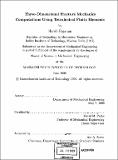| dc.contributor.advisor | David M. Parks. | en_US |
| dc.contributor.author | Rajaram, Harish, 1976- | en_US |
| dc.date.accessioned | 2005-09-26T19:10:13Z | |
| dc.date.available | 2005-09-26T19:10:13Z | |
| dc.date.copyright | 1999 | en_US |
| dc.date.issued | 1999 | en_US |
| dc.identifier.uri | http://hdl.handle.net/1721.1/28214 | |
| dc.description | Thesis (S.M.)--Massachusetts Institute of Technology, Dept. of Mechanical Engineering, 1999. | en_US |
| dc.description | Includes bibliographical references (leaves 130-133). | en_US |
| dc.description.abstract | With the development of CAD packages which can create complicated 3-D models and mesh them with tetrahedral elements with relative ease, the application of finite element techniques in mechanical design has reached unprecedented proportions. However, the extension of these techniques to fracture mechanics studies is hindered by the unavailability of a general method to obtain fracture mechanics singularity strength (J, K1, etc.) for tetrahedral meshes. An approach to obtain these parameters along a 3-D crack front using tetrahedral elements is presented here. The method is then validated on well-known crack geometries using tetrahedral meshes generated from commercially-available CAD-FEA packages or both elastic and elastic-plastic problems. | en_US |
| dc.description.statementofresponsibility | by Harish Rajaram. | en_US |
| dc.format.extent | 133 leaves | en_US |
| dc.format.extent | 7058466 bytes | |
| dc.format.extent | 7075801 bytes | |
| dc.format.mimetype | application/pdf | |
| dc.format.mimetype | application/pdf | |
| dc.language.iso | en_US | |
| dc.publisher | Massachusetts Institute of Technology | en_US |
| dc.rights | M.I.T. theses are protected by copyright. They may be viewed from this source for any purpose, but reproduction or distribution in any format is prohibited without written permission. See provided URL for inquiries about permission. | en_US |
| dc.rights.uri | http://dspace.mit.edu/handle/1721.1/7582 | |
| dc.subject | Mechanical Engineering | en_US |
| dc.title | Three dimensional fracture mechanics computations using tetrahedral finite elements | en_US |
| dc.title.alternative | 3D fracture mechanics computations using tetrahedral finite elements | en_US |
| dc.type | Thesis | en_US |
| dc.description.degree | S.M. | en_US |
| dc.contributor.department | Massachusetts Institute of Technology. Department of Mechanical Engineering | en_US |
| dc.identifier.oclc | 43320058 | en_US |
